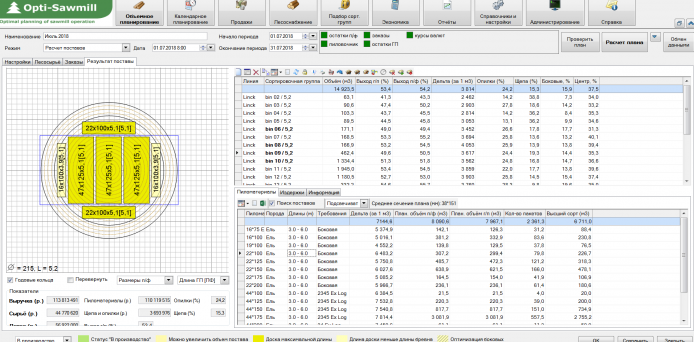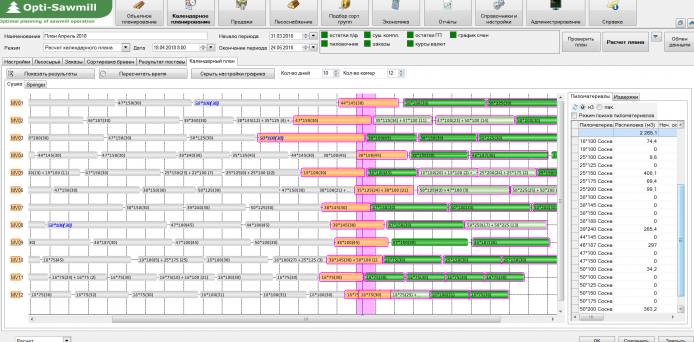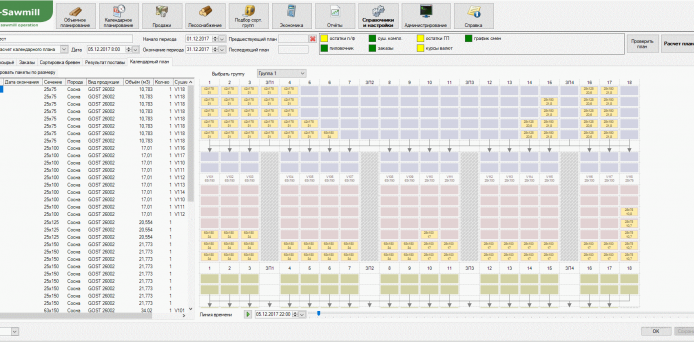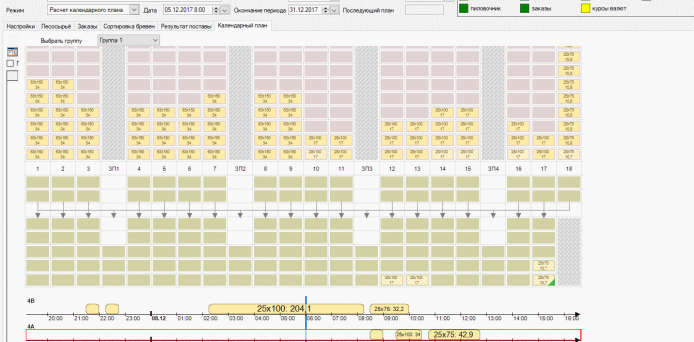Opti-Sawmill
Opti-Plywood is a cloud-based service specifically designed for plywood mills as a tool for optimizing production, starting from peeling and drying of veneer to pressing and cutting plywood.
The service automatically calculates shift-daily tasks, weekly, monthly and other plans, taking into account orders received and planned, their priorities, semi-finished products, technology, and other constraints.
Opti-Plywood allows to optimize financial results of the production program, based on revenue from the sale of all types of products and absolute variable costs, and also to make recommendations for improving the plan, indicating the “bottle-necks”.
The Opti-Wood system operates on two levels of control:
The system takes into account the following production features and limitations:
- The number of saws and side boards
- The thickness of the cut at each pass of the sawmill line
- Linking sawn timber diameters to sawing line and the maximum width of the pattern
- The maximum number of different lumber sizes in the pattern
- The maximum number of different side board sizes
- Maximum thickness and width of sawn timber in the side part
- Available volumes of saw logs by sorting groups
- The minimum volume of one batch for cutting
- Minimum percentage yield of central boards
- The drying chambers volumes
- Minimum and maximum volumes by product types
- Various grades of lumber lengths
- Orders priorities
- Requirements for boards placement in the pattern
- and much more
In drawing up the schedule, the system also takes into account:
- Performance of the saw line in a shift depending on a variety of factors (species, diameter, and length of sawlogs, board sizes, etc.);
- Schedule of equipment operation – shifts schedule, days off, schedule of loading and unloading of drying kilns
- Availability and expected supply of raw materials
- Performance of various production areas
- Volume of drying kilns, the possibility of combining several board sizes in one drying batch




image-by-item-and-alias
image-by-item-and-alias (1)
image-by-item-and-alias (2)
image-by-item-and-alias (3)
Opti-Sawmill uses unique mathematical models and algorithms to effectively address the following main tasks for any number of orders and equipment configuration:
- Using customer orders specifications and logs data (volumes, lengths, diameters), calculate sawing patterns for maximum efficiency of the entire sawmill, and not for each diameter separately
- Calculate the optimal schedule for producing batches of goods with coordination of the entire production line: sawing, drying, dry sorting, and further processing
- Calculate boundaries of log diameters for sorting sawlogs to obtain maximum marginality or volume yield of products
- Reserve finished and semi-finished products for specific customers and account for these reserves when calculating sawing patterns
- Forecast the profitability of the production plan, combining the sales of all types of products, production costs, productivity, and other factors
- Optimize the operation of a group of enterprises by creating a coordinated production plan with optimal allocation of orders between different production sites, as well as comprehensive end-to-end reports
- Simulate current or potential production programs using existing and “virtual” equipment
- Provide recommendations for improving the calculated plan
Advantages
- Increased volume yield and profitability of sawn timber production
- Reduction of time spent by personnel on planning and control procedures due to automation of these processes
- Increased efficiency of obtaining information on key performance indicators of the mill as a whole, and individual orders
- Reduction of in-process inventory at all levels by end-to-end planning and optimization throughout the entire production chain
- Reduction of production orders execution time due to reduced equipment downtimes and tighter schedule
Features
- The System uses Customer accounting systems, which eliminates duplication of information
- Intuitive interface and complete adaptation for Customer processes allow starting the practical use of the System very quickly
- Support of multi-user mode with various functions and access rights
- Support of direct connection to process equipment for data input and equipment control
- Adaptation to Customer specifics

